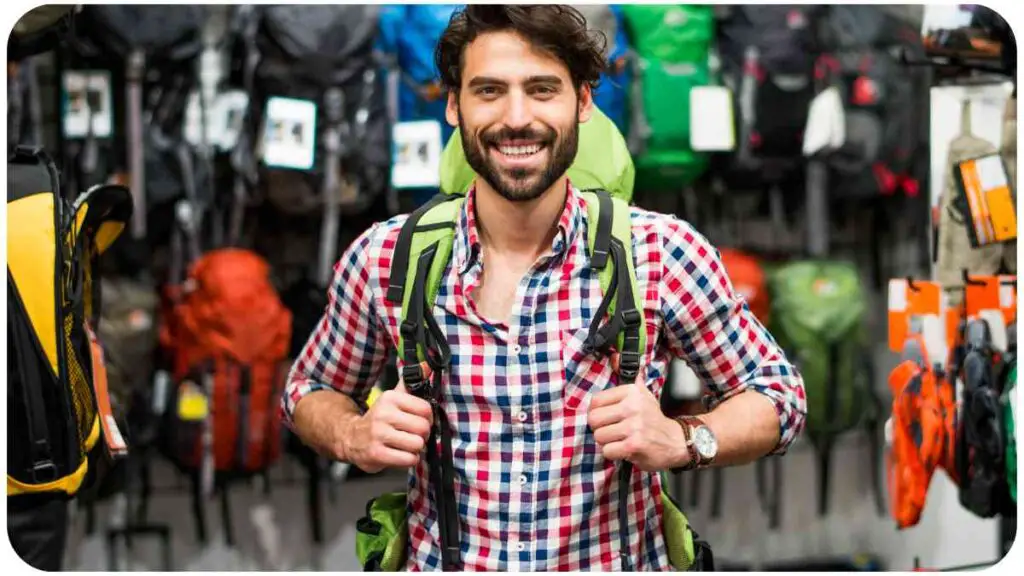Picture this: you’re embarking on an exhilarating outdoor adventure, ready to explore breathtaking landscapes and create memories. One crucial aspect that can either enhance or hinder your experience is the organization of your trusty companion, your Deuter backpack.
In this comprehensive guide, I’ll share invaluable insights gained from years of personal and professional expertise in outdoor expeditions, ensuring that your backpack becomes an organized haven for all your essentials.
| Takeaways |
|---|
| Organizing your backpack enhances your outdoor experience by saving time and reducing frustration. |
| Choosing the right backpack tailored to your activity type and needs is crucial for effective organization. |
| Packing cubes are valuable tools for maintaining order and maximizing space within your backpack. |
| Strategic placement of heavier items promotes comfort and balanced weight distribution. |
| Efficient organization of tech gadgets ensures easy access and protection of your electronics. |
| Quick access pockets and compartments keep frequently used items readily available. |
| Separating clean and dirty items, as well as wet/dry compartments, are essential for hygiene and order. |
| Careful toiletries and personal care products organization contributes to your overall comfort. |
| Proper preparation for changing weather conditions includes rain covers, layering, and adaptable gear. |
| Carrying a well-stocked first aid kit and emergency contact information prioritizes safety. |
| Regular maintenance of your backpack prolongs its lifespan and keeps it in top condition. |
| An organized backpack leads to confident and enjoyable outdoor adventures. |
Why Organizing Your Backpack Matters
Imagine searching frantically for your raincoat during an unexpected downpour or digging through a labyrinth of cables to find your charging adapter. The chaos can quickly turn your exciting journey into a frustrating ordeal.
A well-organized backpack not only saves time but also enhances your overall adventure by allowing you to focus on the experience rather than the mess.
Ensure a seamless outdoor experience with a meticulously curated checklist. From essentials to seasonal considerations, this comprehensive camping checklist covers it all, ensuring you’re well-prepared for your next adventure.
Choosing the Right Deuter Backpack for Your Needs

Selecting the appropriate backpack is the foundation of a successful organization. Different activities demand specific features, such as ample pockets, ergonomic design, and adjustable straps. To simplify your decision-making process, here’s a table comparing various Deuter backpack models tailored to different outdoor pursuits:
| Backpack Model | Activity Type | Key Features |
| Deuter Aircontact | Hiking | Aircontact System, Vari Flex System, Rain Cover |
| Deuter Speed Lite | Trail Running | Lite Air Back System, Hydration System |
| Deuter Futura | Trekking | Aircomfort Sensic Vario Back System |
| Deuter ACT Lite | Climbing | Delrin U-Frame, Gear Loops |
Essential Items for Backpack Organization
Before diving into the nitty-gritty of organization techniques, let’s talk about the foundational items that should find their place in your Deuter backpack. Here’s a table summarizing these essentials:
| Category | Essential Items |
| Navigation | Map, compass, GPS device, trail guidebook |
| Hydration | Water bottle, hydration reservoir, water purification tablets |
| Nutrition | Energy bars, trail mix, lightweight cooking utensils |
| Shelter | Tent, tarp, hammock, emergency blanket |
| Clothing | Weather-appropriate layers, spare socks |
| First Aid | First aid kit, blister treatment, medication |
| Tools | Multi-tool, headlamp, lighter |
| Communication | Smartphone, portable charger, whistle |
| Documents | ID, permits, emergency contact information |
The Art of Efficient Packing
Utilizing Packing Cubes
Think of packing cubes as the architects of order within your backpack. These handy accessories are like puzzle pieces that fit together to create a structured layout. A well-organized set of packing cubes ensures easy access to each item without disturbing the entire contents. Arrange your clothing, accessories, and gear in separate cubes, and let the table below guide you:
Embark on a camping journey with confidence by choosing the right shelter. Explore our guide on the best camping tents that cater to every budget, offering insights into durability, capacity, and features essential for a comfortable stay in the great outdoors.
| Packing Cube | Contents |
| Clothing | T-shirts, pants, socks |
| Accessories | Belts, scarves, hats |
| Electronics | Cables, chargers, gadgets |
| Toiletries | Toothbrush, skincare, toiletries |
Clothing Folding Techniques

The way you fold your clothes can significantly impact space utilization. Try the KonMari folding technique for a compact and organized arrangement. Fold your clothing into neat rectangles to optimize your packing cube space.
Maximizing Space with Compartments
Deuter backpacks often come equipped with multiple compartments. Utilize them wisely to segregate items by frequency of use. Keep frequently accessed items like snacks and maps in the top compartment, while less-needed gear can find its place in the bottom or side compartments.
Strategic Placement of Heavier Items
Distributing weight evenly in your backpack prevents strain and discomfort during your journey. A well-balanced backpack contributes to better posture and reduced fatigue. Here’s a table to illustrate the ideal placement of heavier items:
Prioritize your safety in the wilderness by understanding the fundamental aspects of camping safety. Our guide on the top 10 things to know about camping safety covers crucial tips, precautions, and expert advice to ensure a secure and enjoyable outdoor experience.
| Section | Heavier Items |
| Bottom | Sleeping bag, tent poles |
| Middle | Clothing layers, food supplies |
| Back (closest to body) | Water reservoir, first aid kit |
Tech Gadgets and Accessories Organization
In this digital age, our gadgets accompany us everywhere, even on outdoor adventures. Ensuring their accessibility and safety is vital. Here’s a breakdown of how to keep your tech gear organized:
Cable Management
Tangled cables are the bane of every traveler’s existence. Employ cable organizers or even simple ziplock bags to keep charging cables, earphones, and adapters neatly separated. Refer to the table below for an effective cable management strategy:
| Organizer Type | Usage |
| Cable Clips | Keep cables in place |
| Cable Roll | Prevent tangling |
| Ziplock Bags | Sort by device type |
Secure Laptop Placement
If your adventure calls for a laptop, ensure it’s well-protected. Use a padded laptop sleeve and position it closer to your back to prevent damage. Here’s a guide for secure laptop placement:
Enhance your camping adventure with the right gear essentials. Uncover the must-have camping gear that can elevate your experience, from versatile tools to innovative gadgets. Be well-equipped and ready for any outdoor challenge that comes your way.
| Laptop Sleeve | Features |
| Padded Sleeve | Cushions against impact |
| Waterproof | Guards against unexpected rain or spills |
| Front Loading | Easy access at security checkpoints |
Easy Access to Electronics
When you’re on the move, you don’t want to be rummaging through your entire backpack for your camera or GPS device. Keep these electronics in a dedicated compartment or a top pocket for quick access. Consult the table below for electronic organization tips:
| Electronics Compartment | Recommended Items |
| Top Pocket | Camera, GPS device, compass |
| Electronics Pouch | Phone, power bank, charger |
Stay Hydrated: Water Bottle and Snack Arrangement
Staying hydrated and energized is crucial during any adventure. Here’s how to ensure easy access to your water and snacks:
Water Bottle Placement
Always keep your water bottle within arm’s reach. Side pockets or mesh compartments on the exterior of your backpack are ideal spots. Take a look at the table below for water bottle placement options:
| Water Bottle Holder | Placement |
| Side Pockets | Easy access while walking |
| Mesh Compartment | Quick hydration breaks |
Snack Stash Strategy
Snacks provide quick bursts of energy, so organize them in a way that encourages frequent consumption. Consider these suggestions:
Ensure clean and safe drinking water during your outdoor escapades with proper Lifestraw usage. Dive into our guide on using and cleaning your Lifestraw to maintain its efficiency. Safeguard your hydration source with these essential tips for Lifestraw care.
| Snack Stash | Recommendations |
| Hip Belt Pockets | Small snacks for on-the-go energy boosts |
| Top Compartment | Larger snacks for longer breaks |
| Snack Containers | Keep items from getting crushed |
Quick Access Pockets: Their Significance
Having designated pockets for frequently used items can save you time and frustration. Here’s how to make the most of quick access pockets:
Hip Belt Pockets
These small pockets situated on the hip belt are perfect for storing items you need without taking off your backpack. Keep essentials like your phone, a small camera, lip balm, or a trail map here. Here’s a helpful breakdown:
| Hip Belt Pocket | Essentials |
| Phone | Stay connected on the go |
| Camera | Capture moments instantly |
| Lip Balm | Combat dry lips |
Keeping Clean: Separating Dirty and Clean Items
In the wild, cleanliness is essential for comfort and health. Keep your clean and dirty items separate to maintain order:
Wet/Dry Compartments
Some backpacks come with separate compartments for wet and dry items. If yours has this feature, take full advantage. If not, consider using waterproof bags to isolate wet or dirty clothes.
| Wet/Dry Compartment | Usage |
| Wet Pouch | Stash wet swimwear or rain gear |
| Dry Bag | Protect electronics from moisture |
Navigating Toiletries and Personal Care Products
Staying fresh and clean during your outdoor escapades requires thoughtful organization of toiletries and personal care items:
Waterproof Toiletry Bags
Invest in a waterproof toiletry bag to prevent leaks from ruining the contents of your backpack. Here’s what to pack:
| Waterproof Toiletry Bag | Essentials |
| Toothbrush | Maintain oral hygiene |
| Shampoo | Keep hair fresh |
| Sunscreen | Shield against UV rays |
Compact Toiletry Containers
Opt for travel-sized toiletries to save space and weight. Refer to the table below for suggested compact containers:
| Compact Toiletry Containers | Purpose |
| Travel-Sized Shampoo Bottle | Space-efficient hair care |
| Mini Toothpaste Tube | Maintain oral hygiene on the go |
| Small Sunscreen Bottle | Easily reapply throughout the day |
Shoes and Footwear Compartmentalization
Your footwear plays a crucial role in your comfort and performance. Keep them organized and prevent dirt from spreading:
Shoe Compartments
Many Deuter backpacks feature separate compartments for shoes. If not, consider using a shoe bag to contain any dirt or odors.
| Shoe Compartment | Shoe Options |
| Ventilated Pocket | Air out wet shoes |
| Shoe Bag | Protect clean clothes |
Adapting to Changing Weather Conditions
Outdoor adventures can expose you to unpredictable weather shifts. Here’s how to be prepared for whatever Mother Nature throws at you:
Rain Covers and Ponchos
Invest in a rain cover specifically designed for your Deuter backpack. Additionally, carry a lightweight, packable poncho for sudden downpours. Use the following table as your rainy weather guide:
| Rainy Weather Gear | Purpose |
| Backpack Rain Cover | Shield against backpack moisture |
| Packable Poncho | Stay dry in unexpected rain |
Layering Techniques
Layering is key to staying comfortable in varying temperatures. Here’s how to achieve a versatile layering system:
| Layering System | Layers |
| Base Layer | Moisture-wicking fabric |
| Insulating Layer | Trap body heat |
| Outer Shell | Windproof and waterproof material |
Safety and Medical Supplies: Be Prepared
Safety should always be a top priority. Pack essential medical supplies and be ready for unforeseen situations:
First Aid Kit Essentials
Carry a well-equipped first aid kit that includes bandages, antiseptic wipes, blister treatment, and any necessary medications. Here’s a table outlining crucial items:
| First Aid Kit Essentials | Purpose |
| Adhesive Bandages | Cover minor cuts and abrasions |
| Antiseptic Wipes | Clean wounds to prevent infection |
| Pain Relievers | Address headaches or minor pain |
Emergency Contact Information
Always carry a small card or note with emergency contact information, any allergies you have, and your blood type. This information can be invaluable in case of accidents.
Backpack Maintenance: Prolonging Its Lifespan
Proper care can extend the life of your Deuter backpack and ensure it’s always ready for your next adventure:
Cleaning and Drying
Regularly clean your backpack with a damp cloth to remove dirt and sweat. Allow it to air dry thoroughly before storing to prevent mold and odors.
Storage Tips
When not in use, store your backpack in a cool, dry place. Avoid leaving it in direct sunlight, which can cause the materials to deteriorate.
Conclusion
Organizing your Deuter backpack is an art that combines practicality, expertise, and a touch of personal experience. By incorporating these strategies, you’ll transform your backpack into a harmonious haven for all your outdoor essentials.
Remember, a well-organized backpack not only enhances your adventure but also adds to your overall enjoyment and confidence on the trail. So, go ahead and embark on your next journey fully equipped, organized, and ready to make lasting memories. Happy exploring!
Further Reading
For more insights and tips on backpack organization and outdoor gear, check out these resources:
- How to Pack a Backpack: Deuter’s official guide on effectively packing your backpack for your adventures. Learn about efficient organization techniques and make the most of your space.
- All About Trekking Backpacks: Delve into the world of trekking backpacks with this comprehensive guide from Deuter. Discover the features that make trekking backpacks an essential companion for your journeys.
- Osprey vs. Deuter: Which Backpack is Right for You?: Explore the differences between Osprey and Deuter backpacks in this comparison article. Find out which brand suits your needs and preferences.
FAQs
What is the significance of organizing my backpack?
A well-organized backpack enhances your outdoor experience by saving time and reducing frustration. It allows you to focus on the adventure rather than the chaos of searching for items.
How do I choose the right backpack for my needs?
Choosing the right backpack involves considering factors like activity type, size, features, and comfort. Look for one that aligns with your adventure style and requirements.
What are the benefits of using packing cubes?
Packing cubes keep your items organized, prevent them from shifting, and make it easier to locate what you need. They also maximize space and help maintain order.
How can I keep my electronics safe and accessible?
Use cable organizers to manage your cables, employ a padded laptop sleeve, and keep electronics in designated compartments or pockets for quick access.
What should I include in my first aid kit?
A well-stocked first aid kit should include essentials like adhesive bandages, antiseptic wipes, pain relievers, blister treatment, and any necessary medications.
How can I maintain the lifespan of my backpack?
Regularly clean your backpack with a damp cloth, air dry it thoroughly, and store it in a cool, dry place away from direct sunlight to prevent deterioration.
How do I adapt to changing weather conditions during my journey?
Carry rain covers, packable ponchos, and adopt layering techniques to protect yourself against unexpected weather shifts and maintain comfort.
What should I do if I encounter a wet/dirty clothing situation?
Utilize wet/dry compartments or waterproof bags to separate wet or dirty items from clean ones, ensuring your gear remains organized and dry.
How can I efficiently organize toiletries and personal care items?
Invest in waterproof toiletry bags for leak prevention, opt for travel-sized containers to save space, and keep personal care items in separate compartments.
What’s the importance of emergency contact information?
Carrying emergency contact information is crucial in case of accidents. It helps responders quickly access vital details and provide appropriate care.

I’m Hellen James, and I am a camping enthusiast. I’ve been camping since I was a kid and have always loved it the fresh air, the beautiful scenery, and the great outdoors. In fact, it’s one of my favorite things to do in the summer!


